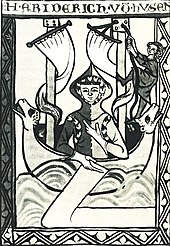Friedrich von Hausen (minstrel)
Friedrich von Hausen (* between 1150 and 1160, exact place of birth unknown; † May 6, 1190 at Philomelium in Asia Minor ) was a German ministerial and minstrel .

Life
Friedrich von Hausen was a ministerial Emperor Frederick I Barbarossa who lived on the Upper Rhine and was one of the earliest minstrels. In research he is equated with a Fridericus de Husen attested between 1171 and 1190; this is the son of homo liber Waltherus de Husen , who is documented in over twenty documents. The father Walter von Hausen owned property in Dolgesheim , Dienheim and Gensingen , as well as the bailiwick of the villages of Worms-Ibersheim and Groß-Rohrheim .
Nothing is known about the place and date of his birth; it appears for the first time together with his father in 1171 in a document from Archbishop Christian von Mainz . Assuming that a boy's ability to carry weapons in the Middle Ages is between 12 and 15 years of age, his birth will be between 1150 and 1160. Various places claim to be his place of birth, but a convincing decision is not possible. A brief note in a copy of a certificate from the Heilbronn Monastery, however, allows the assumption that the ancestral seat of his family was Burg Hausen ("Rheinhäuser Hof") in Mannheim, after which it was named.

Linguistic analyzes of Friedrich's songs, especially his rhymes, have also led to the realization that in all likelihood he is to be settled in the Rhineland-Palatinate area. This is also supported by an undated designation, presumably referring to him, as a fiefdom of the Count Palatine in the Eppstein fiefdoms. A Fridericus de Husen is named here as the owner of a 'feodum' awarded by the Count Palatine, which was ultimately given to Wortwin von Hohenberch after his death . Although this source does not contain any further information on Friedrich von Hausen, he appears as a prominent personality.
There is a gap of eleven years between 1175 and 1186 within the 'documented biography' of Friedrich von Hausen, although the above mentioned fief could be interpreted as a reference to him. However, his mention in two other documents from Archbishop Christian von Mainz in Italy in 1175 is not absolutely certain, since he is only listed there as the son of Walther without being named.
It is not known how Friedrich's rise came about in the following years. However, it must have been very successful, because when it was next mentioned in 1185 it was in the retinue of Emperor Barbarossa's son Heinrich, who later became Heinrich VI. on his trip to Italy to marry Constance of Sicily in January 1186. In 1187 he accompanied Emperor Friedrich I Barbarossa to a meeting with the French King Philip August , and in 1189 he went on the crusade with him . On May 6, 1190, the day before the Battle of Philomelion near today's city of Akşehir, he was killed after falling from his horse, generally mourned by the entire army - a sign of his popularity.
The minstrel
Frederick's socially respected position is of immediate importance for his poetry, as it almost certainly gave him access to Provencal and Old French manuscripts as well as contact with important trouvères of his time.
The minstrel Friedrich von Hausen seems to have been observed by his contemporary witnesses as separate from the ministerial Friedrich von Hausen; in all the documents that have been received, either the minstrel or the politically and socially significant von Hausen is attested. This separation is all the more surprising because historically it should not have existed so clearly. It is very likely that Friedrich took part in important social events such as the Mainz Court Festival in 1184 . Here he is likely to have participated both as a follower of the emperor's son Heinrich and as a minstrel and met the documented Heinrich von Veldeke, Guiot de Provins, Doetes de Troyes and other singers. Similar major socio-political events that occurred during his lifetime are the marriage of Henry VI. 1186 in Milan and the 'Court Day of Jesus Christ' in Mainz 1188, on which von Hausen, along with others, probably also committed himself to participating in the crusade. It is easy to imagine that cruciform songs played an important role in the latter event .
Even if all events and stations in the life of Friedrich von Hausen that are not documented have to remain speculative, they can help to enable access to his artistic work.
The fact that many of his songs fit his biography could easily lead to the assumption that they are biographical art, even experiential poetry. However, this theory must be rejected with all determination, since Middle High German minnesang is a highly artificial and therefore abstract art. The fact that the crusade poetry can be considered an exception here, as it allows historical reality to break into the fictional Minne theme, does not mean that the singers have processed personal experiences, historical figures or places in their songs.
Friedrich von Hausen is therefore a ministerial who is highly respected, especially in his later years, who lived in the immediate vicinity of the emperor and, due to his political function, made several trips abroad, for example to Italy in 1175 and 1186/7. It is obvious that he was one of the emperor's familiares et secretarii and fully integrated into the medieval service system and that it is reflected in his work.
The fact that this “most important mediator between Romance and Middle High German poetry [...]” shaped the genre of the Kreuzlieder in particular is shown by his miniature in the “Weingartner Liederhandschrift”, which depicts him sailing on a ship. His perspective on this 'mixed genre' with elements of politics, propaganda and history on the foil of the Minne theme is also to be examined with regard to his biography, but above all within his songs.
The enormous importance that Friedrich von Hausen has as a juggler with modern and classic elements of the Minnesian poetry is shown in the common term “Hausen School” or “ Rhenish Minnesang ”, which is used in research.
The most famous cross song:
Mîn heart and mîn lîp diu wave decision,
diu with one another would be nu manige zît.
the lîp wants to vehemently address the heathen,
so she has a heart that turns a wîp
before the world. I have to sit there,
that one ándèr doesn’t both.
I have suffered diu ougen vil suffered.
Got a mill to separate the strît.
If I site you, dear heart, don't want to use it,
you wave me vil trûreclîchen lân, so
I ask you that he smells you send
to a place, that you welleenpfân.
Owê! how should ez poor treat you?
how did you kill one in such nôt?
Who should help you end up
with trouble when I have done?
I turn ledic sîn from solicher swaere,
dô I daz kriuze in gotes êre nan.
ez would also reht, daz ez alsô,
wan daz mîn staetekeit me sîn.
I should sîn ze rehte a living man,
whether ez the dumb will sîn verbaere.
Now I see that it’s really immeasurable
how I feel at the end.
Never let me know
if I am hazing the ones I dâ minnet ê.
how vil I sî gevlêhte or asked,
sô tuot si rehte, as sis does not understand.
It darkens me, like the word gelîche gê,
rehte as ez the sumer of triere taete.
I would be a gouch, if I had ir dullness for good
. ez never happens to me.
expenditure
-
Hugo Moser , Helmut Tervooren (Ed.): The Minnesang's spring. 38th edition. Hirzel, Stuttgart 1988, ISBN 3-7776-0448-8 , pp. 73-96. - Older edition:
- Karl Lachmann , Moriz Haupt : The Minnesong's Spring . 2nd Edition. Hirzel, Leipzig 1875, No. VIII, pp. 42-55 ( digitized version ).
- Günther Schweikle (arrangement): Friedrich von Hausen. Songs. Reclam, Stuttgart 1984, ISBN 3-15-008023-1 .
literature
- Günther Jungbluth, Ursula Aarburg: Friedrich von Hausen. In: New German Biography (NDB). Volume 5, Duncker & Humblot, Berlin 1961, ISBN 3-428-00186-9 , p. 599 ( digitized version ).
- Rainer Kunze: Nobility and castles in the lower Neckar valley (11th to 17th centuries), B. Castles in the Mannheim area. In: Hansjörg Probst (Hrsg.): Mannheim before the city was founded. Part II, Volume 1, Pustet, Regensburg 2006, ISBN 3-7917-2019-8 .
- Rüdiger Kurth: An "Elvis" from the Middle Ages. The knight, the minstrel and Hohenberch Castle. In: Yearbook Hochtaunuskreis 2009. Societäts-Verlag, Frankfurt 2008, ISBN 978-3-7973-1110-8 , pp. 186-189.
- Hans-Jürgen Rieckenberg: Life and status of the minstrel Friedrich von Hausen. In: Archives for cultural history. 43, 1961, pp. 163-176 ( digitized version , subscription access).
- Meinrad Schaab: The ministeriality of the churches, the count palatine, the empire and the nobility on the lower Neckar and in the Kraichgau. Hans Jänichen on his 65th birthday. In: Friedrich Ludwig Wagner (Ed.): Ministeriality in the Palatinate area. Lectures and debates at the workshop from October 12 to 14, 1972 in Kaiserslautern. Speyer 1975, DNB 760457190 , pp. 95-121, here p. 111f. (on the assumed relationship with Markward von Annweiler , whose son Dietrich von Hausen inherits the property of Friedrich near Mannheim)
- Günther Schweikle: Friedrich von Hausen. In: The German literature of the Middle Ages. Author Lexicon . 2nd Edition. Volume 2. de Gruyter, Berlin 1980, ISBN 3-11-007699-3 , Sp. 935-947.
- Julius Weichardt: Friedrich von Hausen and the older German minnesang . Rivets, Duisburg 1894 ( digitized version )
- Wilhelm Wilmanns: Friedrich von Hausen . In: Allgemeine Deutsche Biographie (ADB). Volume 11, Duncker & Humblot, Leipzig 1880, p. 86 f.
Web links
- Literature by and about Friedrich von Hausen in the catalog of the German National Library
- Works by Friedrich von Hausen in the Gutenberg-DE project
- Friedrich von Hausen in the Codex Manesse
- Poems with translation ( Memento from December 16, 2005 in the Internet Archive )
Notes and individual references
- ^ Hans Jürgen Rieckenberg: Life and status of the minstrel Friedrich von Hausen. In: Archives for cultural history. Volume 43, 1961, pp. 163–176, and Johann Konrad Dahl : Historical-topographical-statistical description of the city and the office of Gernsheim. Darmstadt 1807. p. 17, cc) Pag. 18 ( Textarchiv - Internet Archive ).
- ^ Mannheim, Schwetzinger Stadt district, Burgstrasse / Rheinhäuser Strasse; see also: Hansjörg Probst (Hrsg.): Mannheim before the city was founded . Part II, Volume 1. Pustet, Regensburg 2006, ISBN 3-7917-2019-8 , pp. 104-105.
- ^ Friedrich Lotz: History of the city of Bad Homburg before the height. Volume 1. Societäts-Verlag, Frankfurt 1977, ISBN 3-7829-0198-3 , p. 37; Compare also Kurth - see literature .
- ^ Text reproduction based on: Hugo Moser, Helmut Tervooren (Ed.): Des Minnesangs Frühling . 38th edition. Hirzel, Stuttgart 1988, ISBN 3-7776-0448-8 , pp. 81-83.
| personal data | |
|---|---|
| SURNAME | Friedrich von Hausen |
| ALTERNATIVE NAMES | Fridericus de Husen |
| BRIEF DESCRIPTION | Middle High German poet of songs of love and crusade |
| DATE OF BIRTH | between 1150 and 1160 |
| DATE OF DEATH | May 6, 1190 |
| Place of death | Philomelium , Asia Minor |